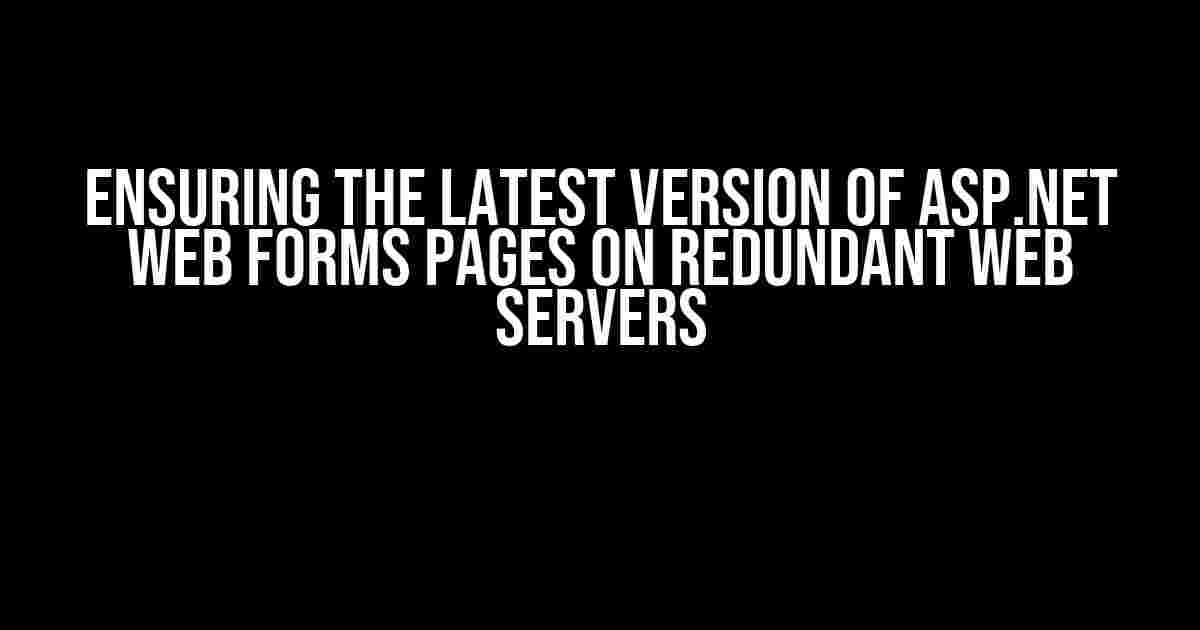As an ASP.NET Web Forms developer, you understand the importance of maintaining consistency across all instances of your web application, especially when it comes to redundant web servers. One crucial aspect of this consistency is ensuring that all web servers have the latest version of specific ASPX and ASCX pages. In this article, we’ll dive into the steps to check and update these pages on your redundant web servers, ensuring a seamless user experience and minimizing potential errors.
Why is it Important to Check for the Latest Version?
Failing to update ASPX and ASCX pages on redundant web servers can lead to a range of issues, including:
- Version inconsistencies: Different versions of the same page can result in inconsistent behavior, errors, and security vulnerabilities.
- Broken functionality: Outdated pages may not work as intended, leading to broken functionality and frustrated users.
- Security risks: Older versions of pages may contain known security vulnerabilities, making your application more susceptible to attacks.
Step 1: Identify the Pages to Check
Before you begin, make a list of the specific ASPX and ASCX pages that require verification. Consider the following:
- Pages with frequent updates or changes
- Pages with critical functionality or security implications
- Pages that are prone to errors or issues
Step 2: Gather Information about the Web Servers
Collect the necessary information about your redundant web servers, including:
| Server | IP Address | Operating System | .NET Framework Version |
|---|---|---|---|
| Server 1 | 192.168.1.100 | Windows Server 2019 | .NET Framework 4.8 |
| Server 2 | 192.168.1.101 | Windows Server 2016 | .NET Framework 4.6 |
Step 3: Check the File Versions
Use the following approaches to check the file versions on each web server:
Method 1: Manual File Comparison
// Connect to each web server using Remote Desktop or FTP
// Navigate to the directory containing the ASPX/ASCX pages
// Note the file modification date and time for each page
// Compare the file versions between servers
Method 2: Automated Scripting
// Create a script (e.g., PowerShell or batch script) to:
// 1. Connect to each web server using Remote Desktop or FTP
// 2. Retrieve the file modification date and time for each ASPX/ASCX page
// 3. Compare the file versions between servers
// 4. Output the results to a log file or console
Step 4: Update the Pages (If Necessary)
If you find that any web server has an outdated version of an ASPX or ASCX page, update the page to the latest version:
Method 1: Manual Update
// Connect to the web server with the outdated page
// Replace the outdated page with the latest version from the source repository
// Verify the update by checking the file modification date and time
Method 2: Automated Deployment
// Configure your deployment process (e.g., Continuous Integration/Continuous Deployment) to:
// 1. Detect changes to the ASPX/ASCX pages in the source repository
// 2. Automatically deploy the updated pages to each web server
// 3. Verify the update by checking the file modification date and time
Best Practices for Maintenance
To ensure consistent maintenance and minimize the risk of outdated pages, consider the following best practices:
- Schedule regular checks for updates to ASPX and ASCX pages
- Implement a version control system to track changes to pages
- Use automated deployment processes to reduce manual errors
- Monitor server logs for errors or issues related to outdated pages
Conclusion
In conclusion, ensuring the latest version of ASPX and ASCX pages on redundant web servers is crucial for maintaining a consistent and secure ASP.NET Web Forms application. By following the steps outlined in this article, you can check and update your pages efficiently, reducing the risk of errors and security vulnerabilities. Remember to implement best practices for maintenance to ensure your application remains up-to-date and secure.
Don’t let outdated pages hold your application back. Take control of your ASP.NET Web Forms application’s consistency and security today!
Frequently Asked Question
Get ready to tackle the redundancy woes of your ASP.NET Web Forms web application!
How can I verify if my web server has the latest version of a specific ASPX page?
You can use the built-in functionality of ASP.NET to check the last modification date of the ASPX page. Simply use the `FileInfo` class to retrieve the file’s last write time. For example, `FileInfo fileInfo = new FileInfo(Server.MapPath(“~/MyPage.aspx”)); DateTime lastModified = fileInfo.LastWriteTime;`
What if I have a complex web application with multiple ASCX user controls? How can I ensure they are all up-to-date?
In this case, you can use a recursive function to iterate through all the ASCX files in your application and check their last modification dates. You can also use a tool like Microsoft’s Web Deployment Tool to synchronize files between environments.
I have multiple web servers in a load-balanced environment. How can I ensure that all web servers have the same version of my ASPX and ASCX files?
To ensure consistency across all web servers, you can use a file synchronization tool like Robocopy or a deployment automation tool like Octopus Deploy. These tools can help you distribute the latest files to all web servers in your environment.
Is there a way to automate the process of checking for updates to my ASPX and ASCX files?
Yes, you can write a simple script or program to automate the process of checking for updates. For example, you can create a Windows task schedule to run a PowerShell script that checks for updates to your files at regular intervals.
What are some best practices for managing ASPX and ASCX files in a redundant web server environment?
Some best practices include using a version control system like Git to track changes to your files, setting up a continuous integration and continuous deployment (CI/CD) pipeline to automate deployment, and implementing a rollback strategy in case of deployment errors.


